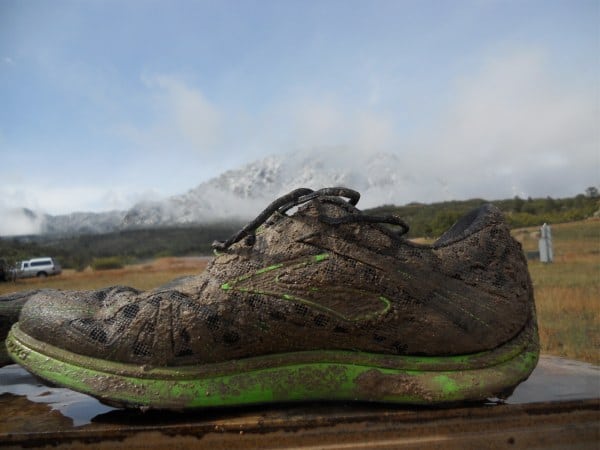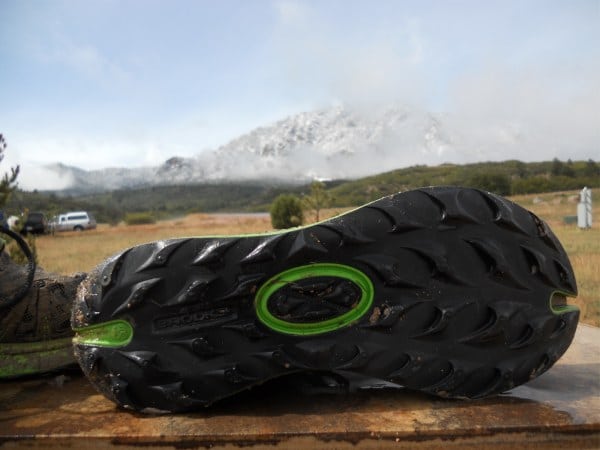Our Favorite Trail Running Shoes
Check out our Best Trail Running Shoes article to learn about our current favorite trail running shoes!
Brooks PureGrit Review
So, I received the Brooks PureGrit on Wednesday and decided to put the shoe through its paces with a few short trail runs. My initial reaction to the shoe had been positive, so I decided to wear it over the weekend in the Xterra Trail Marathon in Colorado Springs. What was supposed to be a nice jaunt on well-manicured rolling trails with really only a few technical sections quickly turned into a major field test. Race day dawned with a steady rain and temperatures in the mid-thirties. Snow was falling on the upper parts of the mountain course and trails that were once wide and well groomed quickly turned into an amalgam of clay, mud, and treachery. Definitely not my favorite weather to race in, but certainly great wear testing conditions.
Bonus: We’ve now added a video review of the Brooks PureGrit to the bottom of this text review.
First Impressions
My initial reaction after trying on the PureGrit was how well cushioned it is while still maintaining a low profile and very agile feel. Weighing in at 8.9 oz (US men’s 9) this shoe is certainly not featherweight but seemed substantial enough for the long haul. The PureGrit has a 4mm drop (15 mm to 11 mm) and the curved last of the shoe made me feel nimble. Add to that an upper that really hugs the foot and the PureGrit received the go as my race day shoe over the Saucony Peregrine, my current workhorse. My only reservation with the PureGrit was whether or not it could hold up on the trails? My initial forays wearing the shoe felt very comfortable on the roads, and I was concerned that the soft cushioning of the PureGrit would not allow me to “feel” the trail.
Upper
An ultra-light dual density mesh really hugs the foot through the length of the shoe. Brooks kept things simple and functional, adding nothing frivolous or purely cosmetic. I didn’t experience any rubbing or discomfort despite basically running a marathon in them out of the box. The tongue of the PureGrit is thin and only padded further towards the toe providing some cushioning under the laces but saving weight and bulk. In keeping with the functional philosophy of this shoe the laces are very thin sausage links style and stayed tied without issue. Overlays throughout the shoe are well placed and kept my foot centered even while running on cambered trails. Brooks included a “Nav band,” an elastic band in the midfoot of the shoe which goes over the laces. I didn’t notice the Nav band enhancing the already glove like fit, and it did make it harder to lace up the shoe tightly. In fact, the Nav band does not even appear taut when I have the shoes fully laced and my feet are average width.
A minimal toe bumper saved me several times as I kicked rocks without damaging my toes at all. The PureGrit also drains very well, as the shoes were soaked for the better part of four hours including multiple times when my feet were completely submerged in puddles. Despite this, they never felt water logged and my feet never attained that shriveled prune look they would have in a shoe that drained poorly.
Midsole
The PureGrit uses BioMoGo with Brooks DNA compound throughout that gives a springy and responsive ride. The midsole cushioning was surprisingly more responsive than anything I’ve ever worn from Brooks. That being said, the PureGrit does not feel like an uber-minimalist shoe. Lovers of the minimalism of a shoe like the New Balance MT101 will probably find the PureGrit’s cushioning too substantial. The fact that I was able to run a marathon in them without feeling too beat up at the end is really a tribute to how functional and protective this cushioning is.
Any reservations I had about this shoe lacking proprioception were quickly dispelled and the PureGrit’s flexibility really allowed me to dig in on torn-up, clay-riddled areas of the trail where traction was dearly needed.
Outsole
The outsole is where the PureGrit really shines. Concepts that initially seemed like gimmicks functioned beautifully on race day. I have to admit, I raised an eyebrow at the PureGrit’s outsole featuring a split toebox designed to allow the big toe to function independently to increase toe splay and balance. For the record, this actually works. On cambered trails and corners the rounded outsole dug into the trail and that extra bit of splay seemed to allow my foot to function more naturally. This outsole cutout also did not seem to pick up any rocks or mud/clay as I thought it would, and this one piece outsole is very flexible and allowed my foot to extend through the entire foot plant.
The PureGrit features an anatomical last, which basically means that the outsole follows the natural curvature of the foot. The edges and heel of the shoe are rounded which helped me through the technical sections of the course where I had to run over large rocks slickened by rain and clay. Brooks designed the curved nature of the heel to help runners land more naturally in the midfoot and the heel-to-toe transition is very smooth. There is also a strike zone “pod” in the center of the outsole which is designed to inform the foot of the shoe’s center. I did not notice any extra cushioning features there, and not noticing is probably a good thing in my book.
I worried that the lug pattern wouldn’t be substantial enough for such bad footing, but again I was pleased to be wrong. Coupled with the flexibility of this shoe, the lugs dug into the trail when I needed it most and I seemed to shed clay and mud from the PureGrit more easily than my fellow racers who complained of their trail running shoes feeling like bricks.
The PureGrit does not have a rock plate, and again I scoffed at this absence. This may be the one area of the shoe which I have not been able to truly test as I did not encounter sharp rocks or scree fields during my wear test. My hypothesis is that the PureGrit will provide enough protection in the midsole save for the most technical and rocky trails.
Overall Impression
Being the skeptic that I am, when a trail shoe is released to a great deal of hubbub and anticipation I naturally look for the shoes vulnerabilities. The PureGrit got me through a horrible day’s conditions in the mountains and I am pleased to report that I cannot find any weak points. Whatever input provided by Scott Jurek and his lifetime on the trails created a fully conceptualized shoe in its inception. On climbs, I felt a great deal of traction, even in wet clay, and the relative light weight of this shoe, at 8.9 oz, didn’t weigh me down. The excellent cushioning allowed me to bomb the downhills, and my legs feel less beat up after a marathon than they ever have. Runners looking for the flexibility and fit of a minimalist shoe with the added protection of a long distance racing flat will find a winner in the PureGrit.
Originally marketed for release in early 2012, the PureGrit is available now (MSRP $100).
Are you eager to get your feet into a pair of Brooks PureGrit? If so, what are you most looking forward to about the shoe?
If you don’t think the PureGrit is for you, why not?




